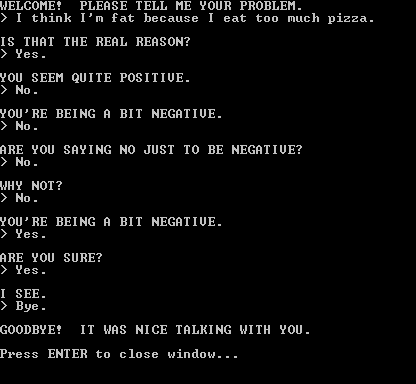So far, we've been selecting a random response from a pattern's set of responses.
We've done this by using Random.Next() to generate an index between zero and the
number of responses, and returning the response at that index. Because the number
of responses for a phrase is relatively small, Random.Next() might return
the same index as before, causing Eliza to sound like she's repeating herself.
To ensure Eliza never repeats a response, let's instead cycle through
each response.
We'll do this by using an integer to keep track of the index of the last used
response. Because different phrases have different numbers of responses, we'll
need a separate index for each phrase. Something like this:
// Index of next response for BECAUSE.
private int _indexBecause;
// Index of next response for YES.
private int _indexYes;
// Index of next response for NO.
private int _indexNo;
What if Eliza grows to recognize a hundred phrases? Or even a thousand? Clearly,
we'll need an index variable for each phrase. This leads to code that's
hard to scale (i.e. expand).
"Is there a way to generalize what I'm doing?"
// Phone number of Bob & Alice Smith
private string _phoneNumberBobAliceSmith;
// Phone number of Paul Hawkins
private string _phoneNumberPaulHawkins;
// Phone number of Samir & Ritu Shah
private string _phoneNumberSamirRituShah;
... about a thousand more variables ...
I hope you said "No!" 
THEN COMPARE YOUR CODE WITH THAT IN THE SOLUTION. Testing your changesNow that you've generalized the Pattern class, run the driver program and verify that Eliza is working correctly, by having the following conversation where the user repeats saying YES and NO.
IS TO HAVE A WAY TO TEST YOUR CHANGES. WHEN DEVELOPING MISSION-CRITICAL SOFTWARE (e.g. SOFTWARE ON WHICH HUMAN LIVES DEPEND), ENGINEERS BUILD THE TESTS BEFORE WRITING THE SOFTWARE. THIS WAY OF DEVELOPING SOFTWARE IS CALLED "TEST-DRIVEN DEVELOPMENT" OR TDD. |